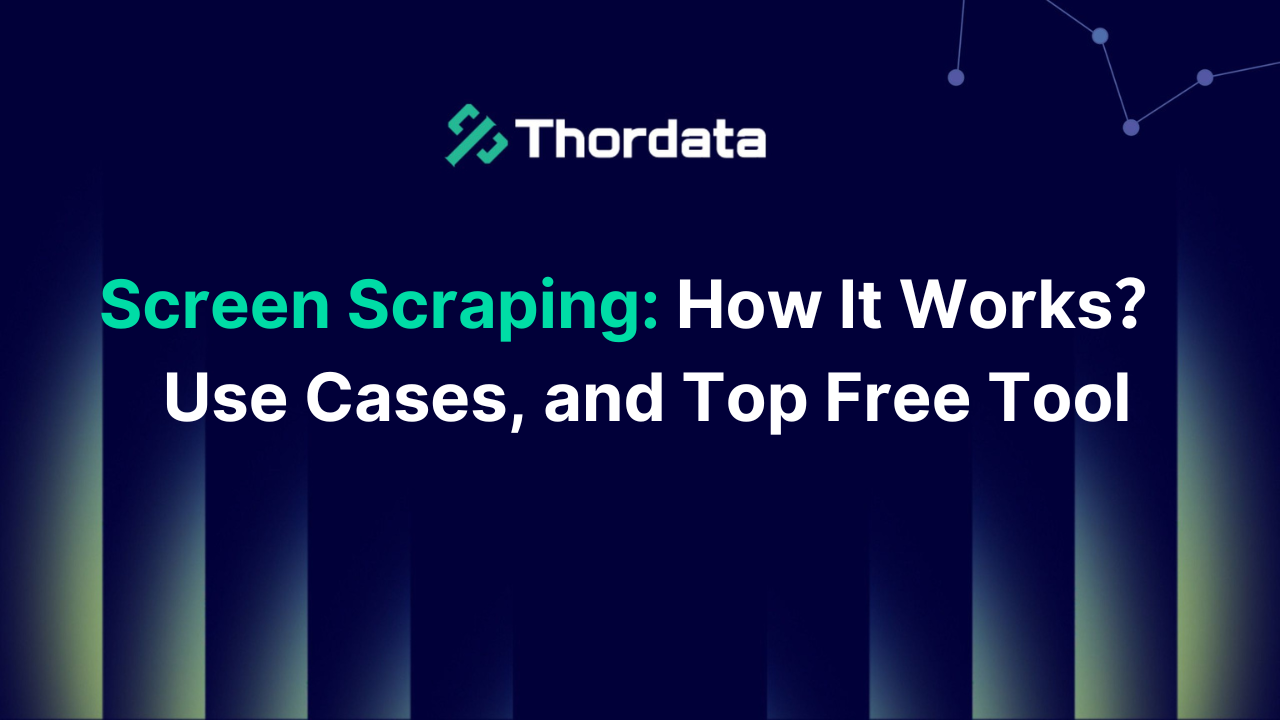Screen Scraping: How It Works, Use Cases, and Top Free Tool


In today’s rapidly evolving digital environment, data plays a pivotal role in shaping decision-making processes and driving innovation across industries. Despite its importance, a large share of the data generated by applications and websites is often difficult to retrieve. This data cannot be easily accessed through APIs. This is where screen scraping becomes a vital tool.
By simulating user interactions with a digital interface, screen scraping allows for the extraction of crucial information from visible screen content. But how does this technology work in practice? What makes it unique, and what limitations does it encounter? This article help you better understand and leverage the potential of screen scraping.
What is Screen Scraping?
Screen scraping is a method for extracting data from the graphical user interface (GUI) shown on a screen. It is commonly used to retrieve information that cannot be accessed directly through an API or database, converting it into an organized and usable format. This process largely depends on automation tools designed to replicate user interactions with the system’s interface.
Unlike APIs, screen scraping involves extracting images, text, and other types of information, typically presented in more complex formats.
This process frequently requires the use of Optical Character Recognition (OCR) technology. OCR technology is used to interpret and extract data. This adds a layer of complexity to its maintenance.
Screen scraping is commonly employed in legacy applications. In these applications, access to source code or documentation is unavailable. This makes screen scraping a practical solution for retrieving data. It helps support application updates.
How Screen Scraping Works
This process frequently requires the use of Optical Character Recognition (OCR) technology. OCR technology interprets and extracts data. This adds complexity to its maintenance.
Screen scraping is commonly employed in legacy applications. In these applications, access to source code or documentation is unavailable. This makes screen scraping a practical solution. It retrieves data to support application updates.
1.Simulating human interactions
Robotic scripts are employed to mimic user behaviors like clicking, scrolling, and typing, enabling access to specific web pages or applications.
2.Analyzing screen content
The scraping tool captures a screenshot of the active page and examines its displayed elements, including text, images, buttons, and more. If the text is embedded in visuals or present within images, OCR technology may be utilized to accurately recognize and extract it.
3.Organizing and gather data in a structured format
Once the data has been extracted, it is stored in an organized format, such as CSV or Excel files.
Use Cases of Screen Scraping
1.Data migration and integration
Facilitates the transfer of data from outdated applications to modern interfaces. This enables businesses to maintain the use of existing data and logic from legacy systems effectively.
2. Financial applications
Banks and financial institutions leverage screen scraping to gather clients’ financial data, such as transaction histories from various bank accounts. This consolidated information provides deeper insights into clients’ overall financial health.
3.Cross-site integration
Without relying on APIs, screen scraping extracts data directly from web pages. It offers flexibility in adapting to diverse webpage structures and handling intricate layouts with ease.
4. Automation of processes
Eliminates the need for manual data entry or repetitive copying tasks by automating these operations. Screen scraping tools can be scheduled to run at regular intervals, accessing pages and retrieving updated data automatically, thus saving significant time and effort.
Screen Scraping VS Web Scraping
Web scraping involves utilizing automated scriping programs to access and analyze the HTML code of a webpage to extract data. This process retrieves content directly from the server by interpreting the webpage’s source code. In contrast, screen scraping simulates user interactions to collect data presented on a computer screen. It is particularly useful for extracting information unavailable through standard web scraping methods or for capturing dynamically rendered content, such as JavaScript-generated visuals.
In data accessing, web scraping focuses on extracting information from the source code. Which is targeting specific HTML tags. However, screen scraping operates at the graphical user interface (GUI) level,capturing information directly from what is visually displayed. This approach is well-suited for legacy systems or cases where content is presented through a graphical interface, instead of static HTML.
| Feature | Web Scraping | Screen Scraping |
| Extraction Method | Directly extracts data from webpage’s HTML code | Extracts data from the graphical interface |
| Applicable Scenarios | Static pages and structured data extraction | Graphical interface, image recognition, and dynamic content extraction |
| Flexibility | Efficient for structured data | Advantages in dynamic and image data, but more complex |
| Technical Requirements | HTML parsing and network request tools | Automation tools, OCR, and image recognition technologies |
| Efficiency | Faster | Slower, especially for image and dynamic content |
| Difficulty | Relatively simple | More complex, requires simulating user behavior and using image recognition and OCR |
Advantages and Disadvantages
Advantages:
Screen scraping can serve as a practical solution in scenarios. Where legacy applications lack modern APIs or when certain data elements are inaccessible through available APIs. It is particularly useful for one-time or urgent data extraction needs. As it is often faster and more convenient than waiting for API development, eliminating dependency on the progress of third-party APIs.
Disadvantages:
The effectiveness of screen scraping is highly reliant on the stability of the application’s user interface. Any changes to the interface can disrupt the scraping process, necessitating constant maintenance and updates. Furthermore, improper implementation may violate privacy regulations or intellectual property rights, potentially resulting in legal complications.
Legal and Security
Legal Risks
Engaging in unauthorized data scraping, particularly when it involves sensitive details such as trade secrets or personal information. Data scraping can expose individuals or organizations to legal repercussions and financial liabilities. To mitigate these risks, you must comply with laws and regulations and terms of service.
Security Risks
Screen scraping can lead to data breaches and security risks. If the scraping tool has risks, it can become a vector for hackers to exploit. Which will result in the loss of personal data and system integrity.
Recommended Free Screen Scraping Tools
1. Selenium
Selenium is a versatile automation testing tool that doubles as an effective solution for screen scraping. It offers support for multiple web browsers. And can emulate user actions like clicking, typing, and scrolling to retrieve diverse data from web pages.
2. BeautifulSoup
BeautifulSoup is a Python library designed for parsing HTML and XML content. It simplifies the process of extracting data from web pages. When you combine it with other tools, you can increase the efficiency of screen scraping.
Why Screen Scraping Relies on Thordata
Thordata offers reliable proxy IPs and data solutions, which are key to successful screen scraping. The major advantages include:
1. Avoiding IP Blocking
Frequent screen scraping requests may be seen as malicious by the target system, leading to IP bans. Using proxy tools can randomly switch IPs, preventing detection and restriction.
2. Wide Coverage
Thordata provides IPs from over 195 countries and regions, supporting data scraping needs from various locations.
3. Security
Using proxies hides your real IP address, safeguarding your privacy and preventing tracking by the target system.
4. Technical Support
Thordata provides customized scraping solutions to solve challenges in complex scenarios. Contact support@thordata.com for your tailored solution.
Conclusion
Screen scraping serves as a highly effective data extraction method, particularly valuable when conventional APIs are unavailable. It addresses unique challenges posed by legacy systems, dynamic web content, and intricate site designs.
However, despite its notable benefits, it introduces potential hurdles such as maintenance complexities and legal concerns. Consequently, prioritizing compliance and robust security measures is crucial. Thordata can help mitigate IP bans and optimize scraping performance.
Frequently asked questions
What is the difference between screen scraping and API?
Screen scraping involves extracting data directly from a user interface (UI) by simulating human actions, such as reading displayed text or identifying visual elements.
In contrast, APIs are built to facilitate structured data exchange. And deliver information in formats like CSV. APIs are generally more straightforward and well-organized compared to screen scraping. Which tends to be more intricate and is typically employed in scenarios where APIs are unavailable.
Is screen scraping legal?
The legality of screen scraping varies depending on several factors, such as the type of data being scraped, the website or application’s terms of service (ToS), and the specific laws in your jurisdiction. It is essential to review the relevant terms of service regarding data scraping and seek advice from legal experts.
Is web scraping malicious?
Web scraping is a neutral tool that can serve both ethical and unethical purposes depending on its implementation and the intentions. Businesses frequently rely on web scraping to gather publicly data. Such as product pricing, customer reviews, or competitor insights, as part of their efforts to study market dynamics.
Is web scraping a bot?
Web scraping is not a bot. But it often requires the use of bots to simulate human behavior and perform automated tasks.
About the author
Clara is a passionate content manager with a strong interest and enthusiasm for information technology and the internet industry. She approaches her work with optimism and positivity, excelling at transforming complex technical concepts into clear, engaging, and accessible articles that help more people understand how technology is shaping the world.
The thordata Blog offers all its content in its original form and solely for informational intent. We do not offer any guarantees regarding the information found on the thordata Blog or any external sites that it may direct you to. It is essential that you seek legal counsel and thoroughly examine the specific terms of service of any website before engaging in any scraping endeavors, or obtain a scraping permit if required.